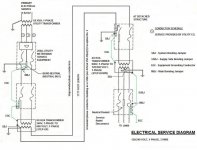Hey everyone! Transformers are not generally something I work on and I need some help with grounding/bonding that I cant seem to wrap my head around... There's a lot of conflicting/confusing information surrounding these out there on different forums and some diagrams completely confict with eachother.
This is for a customer who has service at the front of his property for a farm building but the new house sits back almost 1600' from that service panel. POCO wanted 30k+ to run the line and charges a $50/mo per meter fee so he didn't want the double monthly fee and instead opted to go the xfmr route. Step up/step down is on site (nameplate pictures attached) but I want to get this in my head straight before I put any current through them.
Is my crude paint diagram below correct? I don't need anyone getting hit by 600v so really want to make sure this is 100%. I have also seen some people reference that the enclosure bonding needs to be separate from the ground - couldnt current just travel through the enclosure anyway whether separate/together since they are all bonded together and the enclosures are bonded to ground on both the service panel and secondary sides? If it needs to be separate, I assume that the pre-installed ground lugs are for bonding specifically? Like I said, just really don't want someone (or myself) to get hurt once these are energized so want to make sure this gets done right.



This is for a customer who has service at the front of his property for a farm building but the new house sits back almost 1600' from that service panel. POCO wanted 30k+ to run the line and charges a $50/mo per meter fee so he didn't want the double monthly fee and instead opted to go the xfmr route. Step up/step down is on site (nameplate pictures attached) but I want to get this in my head straight before I put any current through them.
Is my crude paint diagram below correct? I don't need anyone getting hit by 600v so really want to make sure this is 100%. I have also seen some people reference that the enclosure bonding needs to be separate from the ground - couldnt current just travel through the enclosure anyway whether separate/together since they are all bonded together and the enclosures are bonded to ground on both the service panel and secondary sides? If it needs to be separate, I assume that the pre-installed ground lugs are for bonding specifically? Like I said, just really don't want someone (or myself) to get hurt once these are energized so want to make sure this gets done right.



